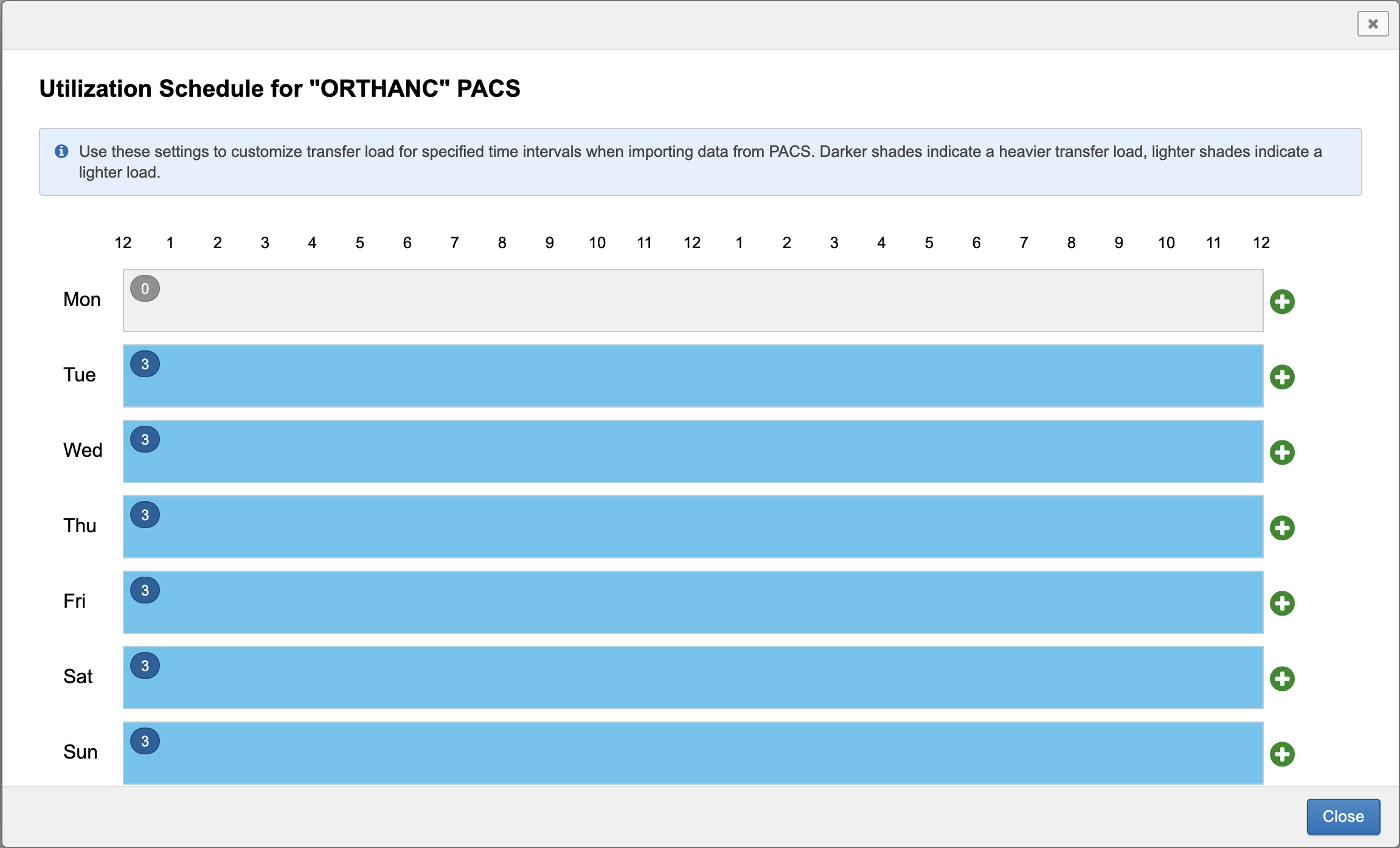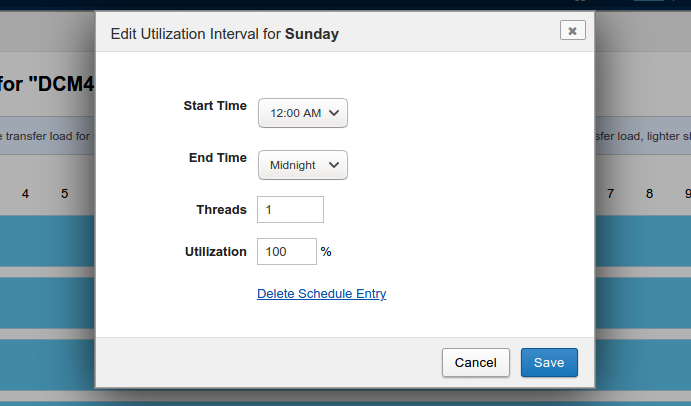DQR Admin: Setting A PACS Availability Schedule
In a high-use, data-rich environment, PACS Administrators may have specific business rules regarding how much network traffic they want to allow to and from their PACS system. The "Schedule" setting allows XNAT Administrators to restrict all use of each connected PACS to certain hours of the day. You can also throttle the data transfer rate, if desired.
To edit the Availability Schedule for a PACS, click the "Schedule" link for that PACS in the table above. The following dialog will open:

This view represents a weekly usage schedule, with all 24 hours of each day represented. By default, a new PACS configuration starts out with a single time interval – represented by a blue bar – covering a full 24-hour day for each day of the week. Availability scheduling has three major chokepoints: 1) start and end time for each time interval, 2) "threads," and 3) "utilization." These concepts will likely be familiar to your PACS Network Administrator, but here is what they mean in XNAT:
| SETTING | DEFAULT | DESCRIPTION |
|---|---|---|
| Start and End Time | 12:00 am / midnight (All day) | A defined time interval for a given day has a set start time and a set end time. For example, a PACS administrator might define three time intervals for a given weekday:
Note: Time intervals cannot overlap. (i.e., you can't define one interval from 6am to 11am, and another interval from 9am to 3pm in the same day.) |
| Threads | 1 | This setting refers to how many DICOM requests you can make simultaneously. |
| Utilization | 100% | This setting refers to your data transfer rate, and tells XNAT whether it should stream data continuously, or insert pauses between file requests. Here is how this works in practice:
|
Here's how to adjust these settings for each time interval in a given day.
Edit An Existing Time Interval
Double click on any of the existing blue bars to open up an "Edit" dialog. You'll see the following:
With 1 thread at 100% utilization, this means that only one study can be imported from a PACS at a time, but once all the data for that study has been received by XNAT, XNAT can immediately ask the PACS for another study. Changing the '1' to '5' would mean that XNAT can have 5 threads performing imports from the PACS at the same time. If you change the 100% to 20%, this means that your thread(s) will at most import for 20% of the time.
Add A New Time Interval
You can add a new time interval definition by clicking the ![]() icon on the right side of each daily time bar. Any newly-defined time interval will overwrite settings for any pre-existing time interval that covers the same start and end time.
icon on the right side of each daily time bar. Any newly-defined time interval will overwrite settings for any pre-existing time interval that covers the same start and end time.
If you do not want the PACS to be available at all during a given time period, you can either delete the schedule entry, or set either the threads or utilization to 0 (setting one to 0 sets them both to 0 since threads do nothing with 0 utilization and utilization does nothing with 0 threads).
Note: Even with Threads or Utilization set to "0", users will still be able to search the PACS and request data. However, those requests will be held in the DQR queue until the next available time interval.
Let's consider a case where a PACS is heavily used during work hours Monday-Friday 9AM to 5PM, but is used much less outside those hours. The PACS administrator might be okay with some imports during work hours, but not with a constant stream of imports. One way you could set the administrator's mind at ease would be to set up your XNAT so that it will at most be pulling studies from the PACS 1/20th of the time. You would do this by making utilization intervals for those blocks of time with 1 thread and 5% utilization. During the rest of the week, the PACS administrator is fine with heavy usage, so you could have 5 threads and 100% utilization for those times if you wanted to. The easiest way to set this up would be to click the '+' sign next to the bar for Monday, select start time: 9AM, end time: 5PM, threads: 1, utilization: 5 and click save:
That adds a new interval on Monday between 9AM and 5PM with low utilization (so a gray colored bar), with 1 thread, 100% utilization still existing for the time periods before and after that. You could then do the same thing for Tuesday, Wednesday, Thursday, and Friday. If you think your usage might be high enough that you want more than one thread during other times, you can double click on each time bar that is set to 1 thread, 100% utilization, and change the number of threads to 5 (or whatever you want). This process can be a little tedious if you want very finely grained settings for your PACS. Thankfully, you will only need to set this up once for a given PACS. Make sure to talk to your PACS administrator to find out what level of utilization they are comfortable with.

